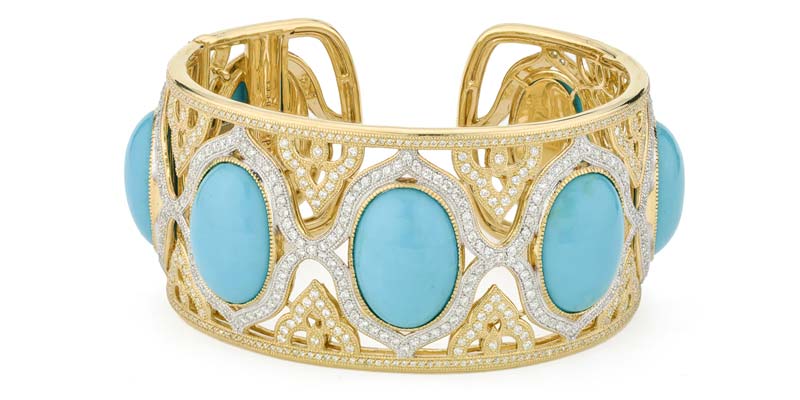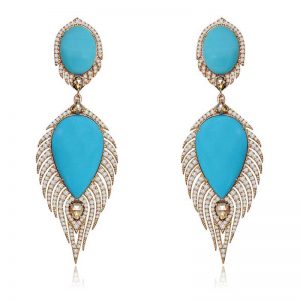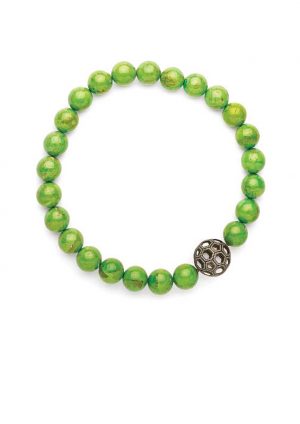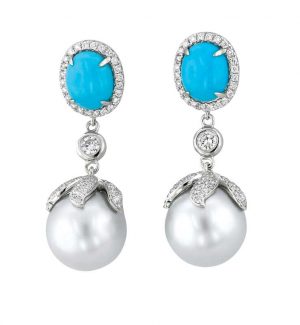Totally turquoise: A refresher on this semi-precious stone
by jacquie_dealmeida | May 1, 2016 9:00 am
By Jo Ellen Cole

Awards shows and fashion runways were awash in turquoise this year. A colour complementing all complexions, this stone tends to have a cyclical popularity that re-writes itself every 20 years or so. Relegated in the recent past to more casual jewellery—think Native American—this new incarnation is increasingly sophisticated, with the heavenly hued stone being partnered more often with gold and diamonds, rather than sterling silver and coral of past designs. Given its resurgence in popularity, a review of its properties may be in order.
The best turquoise is sourced from deposits close to Nishapur in Iran (Persia). The stone acquired its name from the French term for ‘Turkey stone,’ referring to the route by which it travelled to western Europe. Quality turquoise from this locality is of an even slightly greenish-blue colour, with no veining or limonite matrix present. The highest-quality Persian turquoise is semi-translucent and exhibits a rather waxy texture due to its low porosity. In contrast, the more plentiful American and Chinese turquoise tends to have black or brown matrix, respectively, and is more opaque. It’s really a matter of personal preference as to whether the turquoise has matrix or not. That said, material without matrix tends to be more highly valued, especially when somewhat semi-translucent.
Imitations abound

Due to its distinctive signature colour, turquoise was one of the first gems to be simulated. It is often treated or imitated in an attempt to replicate the beautiful colour without the expense of purchasing genuine natural, untreated turquoise. Turquoise can be one of the most difficult gemstones to correctly identify, as it has so many different manifestations due to its ability to be treated and the many imitations that exist. Treatment or imitation can occur in several different ways.
Turquoise itself can be waxed and/or oiled, colour-enhanced with dye, stabilized, re-constituted, or diffused. Even in this day and age of supposed business responsibility, turquoise dealers sometimes submerge their product in water to add weight and colour to rough they are trying to sell. There also exist several minerals that, when dyed, can pass for a plausible turquoise simulant. Waxed and/or oiled turquoise is considered an acceptable trade practice and may help stabilize more porous turquoise. Waxed turquoise can sometimes be detected by holding the tip of a heated pin next to the stone. The heat makes the wax bead up on the stone’s surface. Dyed turquoise is not an accepted trade practice and can often be detected by looking for slight chips along the girdle plane of a cut stone, where the lighter body colour of the original material may be revealed.
Frenchman Pierre Gilson produced the first synthetic turquoise in 1972. ‘Synthetic’ is a designation for a material with the exact same optical, physical, and chemical properties of the natural material, but is grown in a laboratory and produced by man. A lot of this early turquoise synthesis resembled American-type turquoise, rather than the more translucent Persian turquoise.
It has not gained widespread use, as cheaper forms of turquoise simulation exist and are easier to produce. Microscopic examination of this material is crucial to identification. Very small dark-blue spheres are encircled by white groundmass under moderate magnification—this diagnostic appearance is termed ‘cream of wheat.’
Treating turquoise

The Zachary Enhancement Method was developed by James E. Zachary, an electrical engineer and trader of turquoise. Moderate- to high-grade turquoise is subjected to a proprietary chemical bath and then heat-treated. This creates a harder material that
takes a superior polish to natural untreated turquoise. This process doesn’t make the material any stronger, but the effect is achieved without the use of dyes or additional hardening agents. The specific gravity of Zachary-treated turquoise is reputed to be lighter than its natural counterpart.
Stabilized turquoise results from soaking rough low-quality turquoise in a bath of resin, epoxy, or some sort of liquid plastic; newer stabilization methods include using pressure to help impregnate the plastic farther into the turquoise rough. Sometimes, dye is also introduced into the bath to provide a deeper and more even colour distribution. The resultant material after cutting and polishing may exhibit a harder surface with greater lustre. The stabilized turquoise is also protected from dirt and doesn’t display a ‘bloom’ that may occur with turquoise treated with less stable materials (i.e. wax or oil) and which may leak out, changing the colour of the material. Stabilized turquoise may be identified by its lower specific gravity. Superior hardness and a very high lustre are indications the material has been stabilized.
Reconstituted turquoise consists of pieces of natural turquoise that are too small to be useful. These very small pieces are ground into a powder and mixed with a binding agent. The mixture is then moulded into slabs and allowed to dry. After it has dried, it may be sliced, carved, or cut into cabochons. Reconstituted turquoise is very inexpensive to produce and is often found in low-priced fashion jewellery. The specific gravity is lower than that of natural turquoise and is often key in its identification.

Many natural minerals can be dyed to imitate more expensive and well-known turquoise. Some of the more prevalent ones are discussed here. Howlite, magnesite, and dolomite are all distinct minerals in their own right that are generally white in colour and opaque. Both howlite and magnesite can exhibit a black matrix resembling that found in turquoise; when dyed, they make convincing simulants. By inspecting the stone closely, the surface dye is often revealed by small nicks and chips that may be apparent on the cabochon’s girdle. Variscite is hydrated aluminum phosphate that is very similar in appearance to turquoise. Now considered rare and expensive, this stone is sometimes marketed under the term ‘variquoise.’ Chrysocolla is a copper silicate very similar to turquoise in colour, but is much more translucent. It also has become expensive to use as a turquoise simulant; it is currently marketed as chrysocolla and used in both fashion and fine jewellery.
Other natural minerals such as malachite, azurite, Eilat stone (i.e. a mixture of malachite and chrysocolla) and lapis lazuli have been confused in the past, but generally are not used these days as a turquoise simulant. Glass and plastic can also be made to resemble turquoise, but can be easily separated by specific gravity, fracture surface (i.e. conchoidal as opposed to granular), and the possible presence of bubbles.
Jewellers should always be mindful when they purchase turquoise due to possible modifications of the material. Although often treated or imitated, natural turquoise has once again proved itself to be a fashion darling and can also be rewarding for the retail jeweller’s bottom line.
 Jo Ellen Cole has been involved in the jewellery industry since 1978 and currently offers independent gem and jewellery appraisals, as well as consultation, in Los Angeles, Calif. She has a graduate gemmologist diploma from Gemological Institute of America (GIA) and completed her studies at the prestigious Gemmological Association of Great Britain’s F.G.A. After working several years in both retail and wholesale venues, Cole returned to her love of laboratory work when she accepted a job at a jewellery appraisal laboratory, which led to a management position at Guild Laboratories in Los Angeles. In 2014, she accepted a position with Heritage Auctions as a jewellery specialist and cataloguer. Cole can be reached at cupajo819@att.net.
Jo Ellen Cole has been involved in the jewellery industry since 1978 and currently offers independent gem and jewellery appraisals, as well as consultation, in Los Angeles, Calif. She has a graduate gemmologist diploma from Gemological Institute of America (GIA) and completed her studies at the prestigious Gemmological Association of Great Britain’s F.G.A. After working several years in both retail and wholesale venues, Cole returned to her love of laboratory work when she accepted a job at a jewellery appraisal laboratory, which led to a management position at Guild Laboratories in Los Angeles. In 2014, she accepted a position with Heritage Auctions as a jewellery specialist and cataloguer. Cole can be reached at cupajo819@att.net.
Source URL: https://www.jewellerybusiness.com/features/totally-turquoise-a-refresher-on-this-semi-precious-stone/